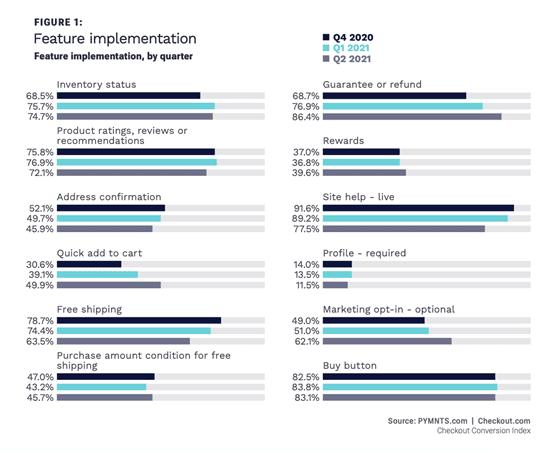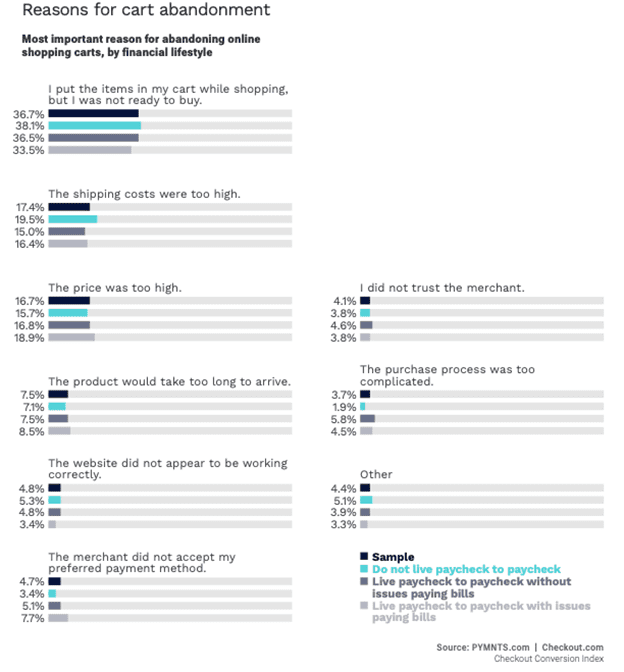Almost anyone who has shopped online knows the experience of picking an item and putting it in the cart only to balk at the shipping price and walk away, often to find a place where getting the product to the front door won’t cost as much or take as long.
Checkout.com Chief Operating Officer Michael Benchimol said it is one of the areas that most commonly drives digital cart abandonment. That assertion supports PYMNTS research. In the Checkout Conversion Index, a collaboration with Checkout.com, researchers found that 48% of consumers say a lack of free shipping is a significant source of friction, with 7.5% noting it as the most important one.
Read more: Checkout Frictions Rise as Some Merchants Pull Back on Value-Adds
However, merchants have been pulling back on offering the feature, with fewer retailers offering it in the second quarter than in previous periods. Just over 63% of merchants offered free shipping in the second quarter of 2021, compared with 79% that offered it at the end of last year.

Speaking to Karen Webster for PYMNTS TV, Benchimol said this is partly because merchants are now facing higher shipping costs due to labor shortages and supply chain bottlenecks around the world.
“An important question for merchants is, ‘How do you weigh the profitability that you’re potentially leaving on the table by offering very attractive shipping options versus the revenue that you’re forgoing by making sure that you optimize on the shipping cost?’” Benchimol said. “There is not going to be a one-size-fits-all answer. I think it will greatly depend on the merchant.”
Processing Payments
Retailers also need to get ahead of one of the other most significant pain points for consumers — the availability of preferred payment methods. Benchimol noted that retailers are increasingly advertising the availability of buy now, pay later (BNPL) or other payment options to “preemptively engage customers” and remove a barrier in people’s minds early in the shopping experience.
“Giving early visibility … hopefully will get more people to the checkout page, and then you need to complete the sale for good,” Benchimol said.
Beyond just accepting payment methods, though, he noted that retailers need to ensure that all of the steps between when a customer hits “pay” and when they receive a confirmation page are stable and reliable so that good transactions don’t get rejected while fraudulent purchases are prevented. Benchimol told Webster that in 2019, retailers lost more than $50 billion in sales due to false declines. When a customer tries to make a valid purchase and gets rejected, they generally don’t retry.
“Conversion is not just the percentage of customers that will end up going and completing the purchase; it’s actually the percentage of transactions that will be successful, and very often, that part is overlooked,” he said.
Many other factors come into play, such as if a provider is not reliable, when banks receive incomplete information or when a webpage is too slow. Seventeen percent of consumers said slow sites were the most important area of friction.
That’s especially true for merchants who are moving into a new market, Benchimol said. It’s crucial to make sure payments are processed domestically to prevent false declines and slow processing speeds.
“There are significant differences in performance when you process a transaction domestically versus when you process a transaction on a cross-border basis,” he said.
Creating a Seamless Experience
Beyond shipping and payment methods, though, consumers have other expectations of the eCommerce experience, many driven by large platforms like Amazon and Shopify. They want to be sure they can trust a merchant, with 40% saying it’s important to see security logos at checkout. They want their purchase journey to involve as few pages and clicks as possible, and they want merchants to guarantee their products or offer refunds for them, among myriad other features.
Up to 30% of consumers abandon an eCommerce purchase once a week because they aren’t satisfied with their experience.

“Clearly, we can see what great looks like, and you won’t find great everywhere,” Benchimol said, because few companies can provide shipping as fast or inventory as vast as Amazon.
Additionally, he added, “the expectations keep going higher, and not everyone is able to deliver on those expectations.”
There are a few things that merchants can do to keep customers engaged or lure back those who have failed to check out, he noted. For one, a clear refund policy, and quality execution of it, is key, Benchimol said, as is providing a seamless and secure checkout experience.
But even if a customer abandons their cart, sending them a reminder email, especially with a coupon code for completing the purchase quickly, can help bring people back to complete the purchase, Benchimol said, “and give them a good reason to do so.”
“It’s a big generic, but basically removing reasons why they may not conclude the sale or giving them a reason to conclude it today,” he said. “A promotion, free shipping, whatever it is, it’s going to go and push towards that higher conversion.”